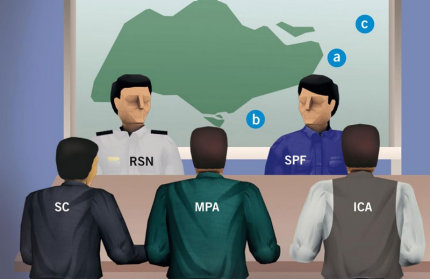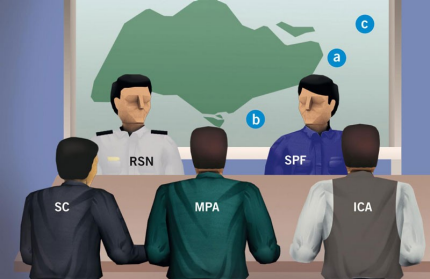OPS & TRAINING
INTEGRATED RESPONSE
08 Dec 2011

The new National Maritime Security System (NMSS) provides a swift and integrated response to threats at sea.
As a whole-of-government approach towards ensuring maritime security, the NMSS analyses maritime threats, and coordinates and executes plans at the national level.
At the heart of the NMSS is the Crisis Management Group for Maritime Security. The group comprises two arms: the National Maritime Sense-making Centre (NMSC) and the National Maritime Operations Group (NMOG).
Both are housed in the Changi Command and Control (C2) Centre at Changi Naval Base. The former collates and analyses maritime information while the latter carries out operations to neutralise maritime threats.
At the Exercise Northstar press conference on 2 Nov, Chief of Staff - Naval Staff of the Republic of Singapore Navy Rear-Admiral Tan Wee Beng spoke on how the NMSS strengthens Singapore's maritime security: "The NMSS provides us with a 24/7 real-time threat evaluation, so that we can get the early warning we need to deal with any impending threat. With these cues, we are then able to mount unified operations that will harness the collective strength of all maritime agencies."
This year's exercise, held from 10 to 25 Nov, validated the workings of the NMSS. The following shows the exercise scenario.
1) 24/7 Active Scanning and Analysis
The NMSC continuously assesses the maritime security environment by identifying anomalies and analysing the situation for any possible threats. Information is shared among operational centres of other national maritime agencies to ensure a uniform understanding of the situation. After picking up a string of seemingly unrelated incidents over several weeks, the NMSC assesses that these incidents may be part of a terrorist plot. The NMOG commences planning across the various maritime agencies, which are alerted to be on the lookout for associated incidents.
2) Terror Plot Assessed
Scanning the maritime environment for the terrorists' possible modes of attacks, the NMSC detects an anomaly: a tanker heading towards Singapore waters which does not transmit its identification signals. A check with MPA and the vessel's shipping agent also indicates that the tanker is not responding to calls. The NMSC assesses that the tanker may be used as a "floating bomb" and activates NMOG to coordinate a multi-agency response to counter the threat. As part of the response plan, RSN and PCG vessels are deployed to intercept and escort the tanker.
3) Threat confirmed
While escorting the tanker, RSN and PCG vessels establish communication with the terrorists on board, who threaten to ram the tanker into one of Singapore's key installations if their demands are not met.
4) National response activated
The terrorists attempt to manoeuvre the tanker towards a key installation. Troops from the SOTF, already on standby, are called in to board the tanker from air and sea to take control of the ship. They are followed by personnel from ICA to check the cargo and the personnel on board the tanker. The MPA's fire-fighting craft stands ready in the vicinity in case of fire emergencies.
Legend
| RSN | Republic of Singapore Navy | PCG | Police Coast Guard | ICA | Immigration & Checkpoints Authority |
| SOTF | Special Operations Task Force | SPF | Singapore Police Force | SC | Singapore Customs |
| MPA | Maritime and Port Authority |
ALSO READ IN OPS & TRAINING

Exercise Wallaby 2025: To see better, shoot faster
31 Oct 2025
The SAF focuses on complex strike missions and multi-domain integration in Exercise Wallaby 2025, the 35th edition of its largest unilateral overseas exercise.

Ex Wallaby 25 – Greater Integration and Complexity
25 Oct 2025
The 35th edition of the SAF’s largest unilateral overseas exercise is an opportunity for expanded scale and deeper integration towards an effective, networked fighting force.

Ex Forging Sabre ramps up use of unmanned assets in integrated strike operations
12 Sep 2025
In this 10th edition of Exercise Forging Sabre, the SAF sharpened its cutting edge for the dynamic modern battlefield, with expanded integration between manned and unmanned platforms.







